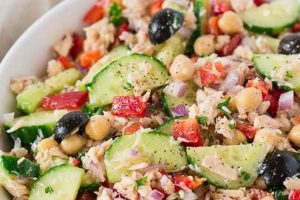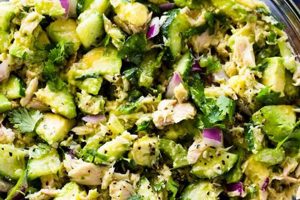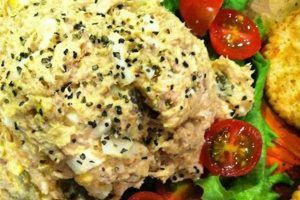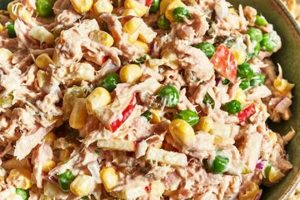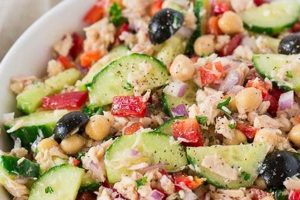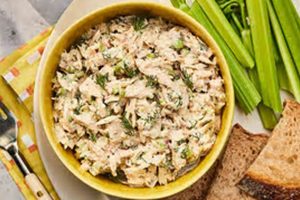A method for preparing a dish combines canned tuna with avocado, creating a nutritious and flavorful meal. Typical additions include mayonnaise, onion, and seasonings, though variations incorporating ingredients like celery, cilantro, or lime juice offer diverse flavor profiles. This dish can be enjoyed as a sandwich filling, a salad topping, or served with crackers or crudits.
This combination offers a good source of protein, healthy fats, and essential vitamins and minerals. Avocado contributes fiber and monounsaturated fats, known for their heart-healthy benefits, while tuna provides protein and omega-3 fatty acids. The versatility of this dish makes it suitable for various dietary preferences, and its relatively quick preparation makes it a convenient and healthy meal option. Its popularity has grown steadily, reflecting increased consumer interest in healthy, flavorful, and easy-to-prepare meals.
The following sections will explore various preparation methods, ingredient variations, and serving suggestions for creating a delicious and satisfying avocado and tuna dish. Nutritional information and tips for maximizing flavor and freshness will also be provided.
Tips for Preparing Avocado Tuna Salad
Optimizing ingredient selection and preparation techniques enhances the flavor and texture of the final dish. Careful consideration of these elements contributes to a superior culinary experience.
Tip 1: Quality Ingredients: Opting for high-quality canned tuna packed in water or oil, ripe but firm avocados, and fresh herbs and spices significantly elevates the overall flavor profile.
Tip 2: Avocado Ripeness: Selecting avocados that yield slightly to gentle pressure ensures optimal creaminess and flavor. Overripe avocados can result in a mushy texture.
Tip 3: Preventing Browning: To prevent avocado browning, incorporate lemon or lime juice immediately after dicing. This maintains the vibrant green color and adds a subtle citrus note.
Tip 4: Tuna Drainage: Thoroughly draining excess liquid from canned tuna prevents a watery consistency in the final product. Flaking the tuna into smaller pieces promotes even distribution within the mixture.
Tip 5: Flavor Balancing: Achieving a balanced flavor profile involves careful consideration of seasonings. A combination of salt, pepper, red onion, and Dijon mustard provides a classic flavor combination.
Tip 6: Mayonnaise Selection: The choice of mayonnaise impacts the overall richness and flavor. Using a lighter mayonnaise or plain Greek yogurt can create a healthier, less calorie-dense option.
Tip 7: Ingredient Incorporation: Gently folding ingredients together prevents overmixing, which can lead to a less desirable texture. This helps maintain the integrity of the individual components.
Attention to these details ensures a flavorful and satisfying culinary experience, maximizing the potential of this simple yet versatile dish.
By understanding the nuances of preparation and ingredient selection, one can consistently create a delicious and nutritious avocado tuna salad.
1. Ingredients
Ingredient selection significantly impacts the final quality, flavor profile, and nutritional value of an avocado tuna salad. Careful consideration of each component contributes to a well-balanced and enjoyable dish.
- Protein Source: Tuna
Canned tuna serves as the primary protein source. Variations include tuna packed in water or oil, influencing the overall fat content and flavor. Albacore tuna offers a milder flavor, while skipjack possesses a more robust taste. Choosing sustainable and responsibly sourced tuna ensures both quality and environmental responsibility.
- Healthy Fat: Avocado
Avocado contributes healthy fats, creamy texture, and essential nutrients. Ripe, yet firm avocados provide optimal flavor and prevent a mushy consistency. The avocado variety can also influence the final product; Hass avocados are common, but other varieties offer subtle flavor differences.
- Binding Agent & Flavor Enhancer: Mayonnaise
Mayonnaise binds the ingredients and adds a creamy, tangy element. Variations include traditional mayonnaise, light mayonnaise, or even plain Greek yogurt for a healthier alternative. The quantity used directly affects the salad’s richness and overall calorie content.
- Aromatic Elements: Seasonings and Vegetables
Seasonings and vegetables enhance the flavor profile and add complexity. Common additions include diced red onion, celery, cilantro, Dijon mustard, black pepper, and salt. These elements provide textural contrast and contribute to the overall sensory experience. Incorporating fresh herbs or spices allows for customization and creativity.
The interplay of these key ingredients determines the final character of the avocado tuna salad. Balancing the proportions of each element contributes to a harmonious and flavorful outcome. Understanding the role and impact of each ingredient allows for informed choices and greater control over the final product, leading to a more satisfying culinary experience.
2. Preparation
Preparation significantly influences the final quality and palatability of avocado tuna salad. Methodical procedures ensure optimal ingredient integration and flavor development. Careful attention to each step contributes to a superior culinary outcome. For example, improper avocado handling can result in browning and a less appealing presentation. Similarly, inadequate draining of the canned tuna can lead to a watery salad. Thorough and consistent preparation techniques enhance the overall dining experience.
Specific preparatory steps directly impact the salad’s texture and flavor. Dicing the avocado and red onion into uniformly sized pieces ensures even distribution and consistent mouthfeel. Thoroughly draining the tuna prevents excess moisture, maintaining the desired consistency. Gently folding the ingredients together, rather than aggressive mixing, preserves the integrity of the components, preventing a mushy texture. These meticulous actions contribute to a more refined and enjoyable salad.
Mastering preparation techniques elevates the avocado tuna salad from a simple combination of ingredients to a carefully constructed dish. Consistent execution of these steps ensures predictable and desirable results. Understanding the impact of each action on the final product allows for greater control over flavor and texture. This knowledge empowers individuals to consistently create a high-quality avocado tuna salad, enhancing culinary satisfaction.
3. Proportions
Proportions play a critical role in determining the final flavor profile and overall enjoyment of avocado tuna salad. The balance between tuna, avocado, mayonnaise, and other ingredients significantly influences the taste experience. Careful consideration of these ratios is essential for achieving a harmonious blend of flavors and textures. An excess of mayonnaise can result in an overly rich and heavy salad, while insufficient avocado may lead to a dry and less flavorful outcome. The interplay of these components requires precise balancing to achieve the desired culinary result.
Consider a scenario where the ratio of tuna to avocado is significantly skewed. A dominance of tuna might create a fishy and less creamy salad, whereas an abundance of avocado could overwhelm the other flavors, resulting in a bland dish. Similarly, the proportion of seasonings and aromatics, such as red onion or cilantro, must be carefully calibrated. Too much onion can overpower the delicate flavors of the tuna and avocado, while too little might leave the salad lacking in complexity. Achieving a harmonious balance requires an understanding of how each ingredient contributes to the overall flavor profile and adjusting the quantities accordingly.
Understanding the impact of proportions allows for customization and tailoring of the recipe to individual preferences. Some may prefer a chunkier salad with more prominent pieces of avocado, while others might favor a smoother, more homogenous blend. Adjusting the ratios allows for control over texture, creaminess, and the overall intensity of flavors. This flexibility empowers individuals to create a personalized version of the classic dish, maximizing enjoyment and culinary satisfaction. Mastery of proportions ensures consistent and predictable results, transforming a simple combination of ingredients into a well-balanced and flavorful culinary creation.
4. Flavor Profile
Flavor profile significantly influences the overall sensory experience of avocado tuna salad. Careful consideration of individual components and their interactions determines the final taste outcome. Understanding how various ingredients contribute to the overall profile allows for customization and optimization of the recipe.
- Classic Profile
The classic flavor profile emphasizes the natural flavors of tuna and avocado, complemented by subtle seasonings. Traditional ingredients like mayonnaise, Dijon mustard, red onion, salt, and pepper create a balanced and familiar taste. This profile appeals to a broad audience and serves as a versatile base for further customization. For example, a classic profile might be preferred for a simple lunch sandwich, allowing the core ingredients to shine.
- Zesty Profile
A zesty profile incorporates bright, citrusy notes to enhance the richness of the avocado and tuna. Ingredients like lime juice, cilantro, and jalapeo peppers add a refreshing kick. This profile offers a lighter, more vibrant alternative to the classic version. A zesty avocado tuna salad might be served as a filling for tacos or as a topping for grilled fish.
- Spicy Profile
A spicy profile introduces heat and complexity to the salad. Incorporating ingredients like sriracha, chili flakes, or diced chipotle peppers adds a fiery dimension. Balancing the heat with the creamy avocado and savory tuna is crucial for achieving a palatable outcome. A spicy avocado tuna salad pairs well with crackers or as a filling for lettuce wraps.
- Mediterranean Profile
A Mediterranean profile draws inspiration from the flavors of the Mediterranean region. Ingredients like Kalamata olives, feta cheese, sun-dried tomatoes, and oregano create a savory and aromatic experience. This profile offers a unique twist on the traditional avocado tuna salad, expanding its culinary versatility. A Mediterranean-inspired version might be served with pita bread or as part of a larger mezze platter.
The flavor profile of avocado tuna salad offers a wide range of possibilities, allowing for customization based on individual preferences and desired culinary applications. Understanding the interplay of ingredients and how they contribute to specific profiles empowers individuals to create tailored versions of this versatile dish. Whether seeking a classic, zesty, spicy, or globally inspired flavor, careful selection and balancing of ingredients are key to achieving a satisfying culinary result.
5. Serving Suggestions
Serving suggestions represent a crucial component of any recipe, including avocado tuna salad, by enhancing its versatility and appeal. The manner in which a dish is presented and consumed directly impacts perceived flavor and overall enjoyment. Thoughtful serving suggestions elevate a simple recipe into a multifaceted culinary experience. Consider the difference between serving avocado tuna salad on plain white bread versus a flaky croissant or within crisp lettuce cups. The chosen vessel influences not only the presentation but also the textural interplay and overall sensory experience. Further, serving suggestions provide practical guidance, broadening the recipe’s applicability to various meal occasions, from a quick lunch to a more formal appetizer.
Specific serving suggestions for avocado tuna salad demonstrate this principle. Serving the salad as a sandwich filling, whether on whole-wheat bread, a croissant, or a baguette, offers a classic and convenient option. Alternatively, using the salad as a topping for crackers or crudits presents a lighter, more shareable format suitable for appetizers or snacks. Incorporating the salad into a larger dish, such as a stuffed tomato or avocado half, elevates the presentation and adds nutritional value. Each serving suggestion transforms the same basic recipe into a distinct culinary creation, catering to different palates and occasions. These examples highlight the practical significance of considering serving suggestions as an integral part of recipe development and presentation.
Effective serving suggestions broaden the appeal and practicality of recipes. They provide consumers with creative options for enjoying a dish, increasing its adaptability to various contexts. By considering presentation, texture, and overall meal composition, serving suggestions enhance the perceived value and enjoyment of a recipe. This attention to detail elevates the culinary experience, transforming a simple avocado tuna salad into a versatile and satisfying meal option adaptable to a variety of dining occasions and preferences.
Frequently Asked Questions
This section addresses common inquiries regarding the preparation, storage, and variations of avocado tuna salad. Clarification on these points aims to provide a comprehensive understanding of this versatile dish.
Question 1: How long can avocado tuna salad be stored?
Refrigeration in an airtight container is recommended for up to three days. Prompt refrigeration helps maintain freshness and prevents bacterial growth. Exposure to air accelerates oxidation, particularly in the avocado, leading to browning and flavor degradation.
Question 2: What are the best methods for preventing avocado browning in the salad?
Incorporating lemon or lime juice immediately after dicing the avocado helps prevent enzymatic browning. Storing the salad with the avocado pit submerged in the mixture can also minimize discoloration. Airtight containers further limit oxidation by reducing exposure to oxygen.
Question 3: Can alternative ingredients be substituted for mayonnaise?
Plain Greek yogurt or mashed avocado can provide a healthier alternative to mayonnaise, reducing overall fat and calorie content. These substitutes also offer a different textural experience, potentially creating a lighter, less dense salad. Other options include hummus or a mixture of olive oil and lemon juice.
Question 4: How can the nutritional value of avocado tuna salad be maximized?
Incorporating nutrient-rich additions such as chopped celery, red onion, or bell peppers enhances the vitamin and mineral content. Choosing tuna packed in water instead of oil reduces overall fat intake. Using whole-grain bread or crackers for serving adds fiber and complex carbohydrates.
Question 5: What are some suitable variations for individuals with dietary restrictions?
For gluten-free diets, the salad can be served with gluten-free bread, crackers, or lettuce wraps. For dairy-free diets, ensure the chosen mayonnaise alternative is dairy-free. Adjustments in seasonings can cater to specific dietary needs or preferences, such as reducing sodium for low-sodium diets.
Question 6: Can avocado tuna salad be frozen?
Freezing is not generally recommended as it can negatively impact the texture of both the avocado and mayonnaise. Thawing often results in a watery consistency and a less desirable mouthfeel. It is preferable to prepare and consume the salad within a few days for optimal quality.
Proper preparation, storage, and ingredient selection ensure a safe and satisfying culinary experience with avocado tuna salad. Understanding these aspects allows for informed choices and customization to suit individual dietary needs and preferences. These guidelines contribute to a greater appreciation and enjoyment of this versatile dish.
The following section will explore additional recipe variations and creative serving suggestions for avocado tuna salad.
Conclusion
Exploration of methods for preparing avocado tuna salad reveals the importance of ingredient quality, careful preparation techniques, and balanced proportions. Fresh, ripe avocados and high-quality tuna form the foundation of a flavorful dish. Proper handling, including preventing avocado browning and thorough tuna drainage, ensures optimal texture and taste. Balancing the proportions of tuna, avocado, mayonnaise, and seasonings contributes to a harmonious flavor profile. Furthermore, diverse flavor profiles, ranging from classic to spicy, demonstrate the dish’s adaptability to a variety of palates. Serving suggestions, including sandwiches, crackers, and salads, highlight the versatility of avocado tuna salad as a meal component.
Avocado tuna salad offers a nutritious and adaptable meal option. Its potential extends beyond a simple lunch or snack; creative variations and thoughtful presentation elevate the dish to a satisfying culinary experience. Continued exploration of ingredient combinations and serving methods promises further enhancement of this versatile recipe, solidifying its place as a healthy and enjoyable dietary staple.

